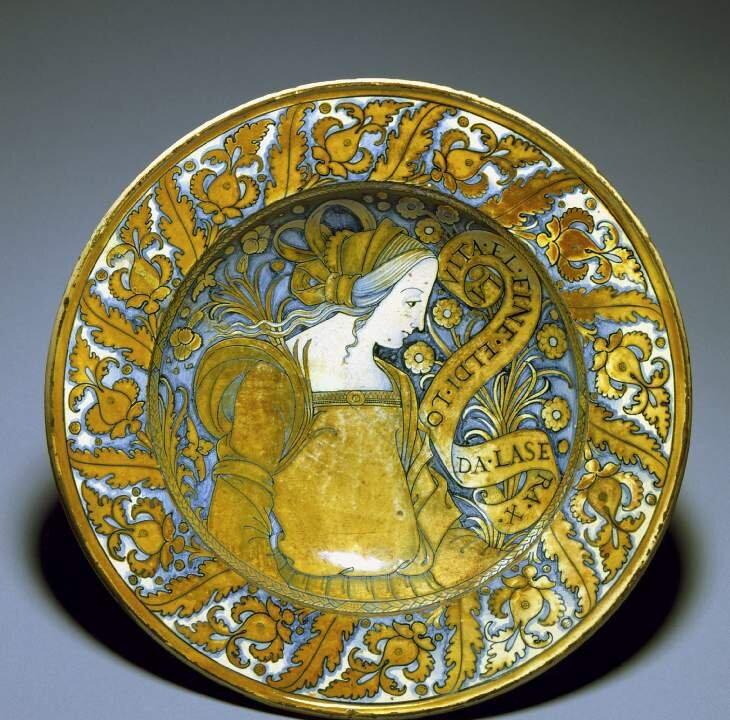Deruta bella donna plates, c. 1500-1550, with their vivid gold coloring and serene female figures, are easy to detect in museum collections.
So detectable are they that they often do not require the scholar’s trained eye to identify them as the work of Deruta artisans from the small Umbrian town located fifteen miles from Perugia.
There are over 400 Deruta bella donna plates existent today. This large number is a testimony to their cultural relevance, and, given the attrition of time, may be just a fraction of what was originally produced.
Historical evidence, namely from a poem written in 1557, entitled “To the Master of the Pots at Deruta,” reveals that these plates were part of a courtship ritual (Ballardini, 1934, p. 110-114).
A suitor commissioned a bella donna plate for his sweetheart. These plates were both an engagement gift and a love charm. The poet Andreano encouraged the Deruta potters to make these plates during the appropriate lunar phase, so they would sell, and the love match would be fortuitous.
While this poem provides a fanciful perspective on the Renaissance Italian romance, a close examination of bella donna iconography reveals that they served a more serious social function.
In fact, aspects of the plates impart a deep-seated anxiety among Umbrian families regarding the conduct of their new family member.
Married life brought with it enormous challenges for a woman in her adolescence (15-19 years of age). Not only was she departing from her parents’ home and entering a new one, but she would also be responsible for its care.
As Leon Battista Alberti wrote, the wife was the ornament of the family; the image she projected to the community became synonymous with family reputation. (Pellegrini, 1946, p. 354)
These plates initiated the future bride into her new role. A close examination of the bella donna figure reveals gestures that, when modelled by the wife, would ensure she avoided potential blemishes to her character. The eyes were downcast, the posture rigid.
Additionally, the dress was austere—there were no furs, expensive velvets, or elaborate jewels—a strange omission for an art object depicting illustrious court women such as Isabella d’Este (Kovesi-Killerby,1994, p.119; 2006, p. 784).
Finally, the plates were inscribed with sentiments illuminating the conjugal virtues (Ajmar, Thornton, 1998, p. 114), specifically to: cultivate silence, be dutiful and unconcerned with physical beauty.
Most tellingly, the plates encouraged young women not dwell on their fate because no one is happy with theirs, Nemo sua sorte contentus erat. (It. ‘No one is content with their own lot’).
Why was there so much concern regarding the wife’s role? In modern society a homemaker is considered a traditional role (Orlandi, 1965, p. 272). However, this was not the case for the sixteenth century Italian middle class, where the wife’s duties had undergone a dramatic shift.
In the Middle Ages non-aristocratic wives worked alongside their husbands on feudal farms. Working exclusively inside the household was a reorientation in the wife’s role. (Herlihy, 1990, p. 156, 162, 167; Bell, 1999. 123). This change was indicative of a restructuring in Italian society. After centuries of plague the population had declined radically, and for those surviving, immense opportunities lay ahead (Goldwaithe, 1989, p.17).
Economic advancement also brought social anxiety. Seamless assimilation into upper-class society required refinement. In Italian Renaissance society a carefully managed image was essential.
The publication of educational manuals calmed social fears, training neophytes in the finer arts of dancing, cooking, dressing, banqueting, and decorating (Bell, 1999, p. 213).
The most popular of all was Cherubino of Siena’s (c. 1497) manual on marriage. He informed husbands how to mould their wives into a paragon of virtue. He added that this could be achieved in two ways.
First, the husband should become his wife’s teacher and moral guide. Second, he should buy comportment manuals to supplement her instruction. Cherubino of Siena also advised husbands to locate his manual and others within his wife’s reach, thereby surrounding her with the appropriate influences. (Zambrini, 1969, p. 9)
In a sense, a bella donna plate was a visual embodiment of a comportment manual (Gilbert, 1980, 145-6). When a young wife gazed at a bella donna plate she would learn from it the qualities necessary to bring honor to her family. Therefore, it was a suitor’s investment in the future. It was not simply a charming symbol of romantic devotion, but also an assurance that his future bride would dedicate herself to a prescribed moral pathway, one that would elevate his reputation and prestige.
Angela Clarke is the museum curator at the Italian Cultural Centre. Vancouver, BC. She holds a Ph.D. in Interdisciplinary Studies, specializing in Italian Renaissance decorative art. She is currently completing a book on bella donna plates. Email her at [email protected]
